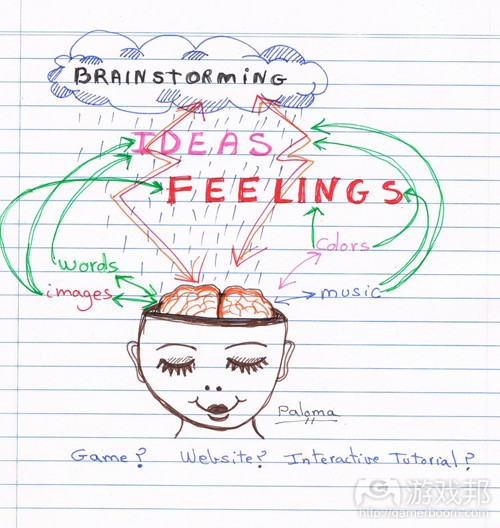为什么头脑风暴行为不等于游戏设计?
作者:Adam Saltsman
当我们继续讨论“头脑风暴”(或称集思广益)一词之前,我认为最好能够阐明涉及头脑风暴中的各种行动。我认为与这一概念相关的做法包括:
想出并记下观点,使用或者脱离辅助工具
与同事或者潜在受众交流意见(口头或者书面形式)
想象或者勾勒出一些观点
我不认为我漏掉了哪一点,如果真的有所遗漏我愿意随时补充上来。按照上述列表的说法,我们可以把头脑风暴定义为未经测试的观点的集合,规划和探究。通过在开发初始阶段发挥我们的想象力和判断力能够更好地控制今后工作的范围和方向。有时候我会认为正式的头脑风暴很浪费时间,但是不可否认,勾勒观点也是一种创造性的过程。
头脑风暴 vs 游戏设计
如上所述,在头脑风暴过程中我们可以将观点写在纸上,但是却不需要去测试这些观点是否可取。我认为,尽管头脑风暴很有趣也很重要,但是因为它只能生产出一些未经测试的观点,所以并不能等同于游戏创造,也不属于游戏设计的过程,虽然在游戏设计过程中我们也需要规划并思考一些观点。
显然,从游戏设计文学,教育和教程来看,头脑风暴注定是一个备受争议的话题,而我将在此做出解释。首先,这并不是用来判断头脑风暴的价值所在。热衷于头脑风暴并不能说明你的水准低,不是游戏设计者或者疯狂地着迷于这种行为。思考一些问题并与好友,同事甚至是家庭成员进行讨论是我在勾画游戏观点时所采用的关键步骤。
其次,没有其它艺术形式或者学科能够用于记录未经测试但是具有内在价值的观点,或者把其当成实际过程的重要方面。举个例子来说,假设我们是生活在1500年左右的意大利文艺复兴艺术家。与游戏制作者一样,我们也是多学科人才,热爱很多东西,如艺术,科学等等。我们决定于明年推出手上正在进行的一项项目,即绘画作品。除此之外我们也在做一些其它事,但是我们却想要尝试一些不一样的新事物。所以我们开始进行思考,即头脑风暴,看看你是否愿意尝试:
雕塑?
哲学?
绘画?
绘画听起来不错!那么在这过程中应该包含哪些内容?
恩,肖像画听起来很有趣,我从来没有尝试过
那就进行肖像画吧!但是以贵族为模特的肖像画好像很泛滥,让我们想想其他对象…
我认为女性不错
那就画女性肖像画,让我们明确一些特征:
调色板:棕色,黄色,还可以加点绿色
质朴的容貌,中立的姿势,简单的着装
田园背景
难以捉摸的表情
我认为这些观点本身并没有任何价值。从这个虚构的清单中我们可以看出,通过思考观点我们能够压缩自己的关注点或兴趣,并制作一个清单帮助我们明确自己想要从绘画中获得什么,而这看起来还是很有帮助的。
显然,这种头脑风暴与真实的《蒙娜丽莎》还是不能相比较的。不只是因为我们在头脑风暴中获得的观点都是未经测试和验证的,而且它们仍然很抽象(尽管它们具有不可匹敌的独特性),即我们有可能会按照这种抽象的概述画出一大堆图画。回到过去,如果在达芬奇创造《蒙娜丽莎》的时候出现了这一灵感清单(事实上并没有),那么头脑风暴的价值度将会大大被提升吧。但是现在,如果观点未经实验或者创造过程的洗涤,也只会被当成是没有价值的东西。
既然如此,我们为何还要喋喋不休地进行头脑风暴呢?考虑了所有情况之后,区别于游戏设计的头脑风暴又有何重要性呢?还有很多有抱负的设计者,努力的年轻设计师以及游戏产业或者艺术外行人仍然相信记录观点等同于创造一件有意思的作品。而这一错误观点将会继续影响整个产业以及相关人员,包括公司雇员,玩家,粉丝以及来自于不同领域的艺术家等。这么做不仅是错误的,而且还不能正确表达出各个学科的观点,不论是科学还是艺术。
想法 vs 执行力
每当我们谈到复制品时,总会有人辩解道“想法是廉价的,执行力更重要。”也许你已经准备好这么一个措辞来反击我的说法了。我知道,对于这一规则肯定有例外存在,虽然我现在暂时想不起来可以论证的观点。但是这一措辞却帮助了《愤怒的小鸟》或《忍者钓鱼》的存在做出了辩解,要知道这两款游戏的创意均立足于原有的其他成功游戏。
看这篇文章的前半部分似乎都在斥责头脑风暴的缺点,而我也支持这一表达,毕竟我还是认为想法是廉价的。问题就在于,这些游戏的诞生并不是源自白色书写板上的想法,然后经过测试证实并详细规划而来的,而是开发者复制已存在的游戏得来的。
如果有人在自己的博客上写下一些未经验证和测试的游戏想法,而其他人抓住这些想法对其测试并基于其中一些概念创造出一个真实的游戏原型,那么当这个人哭诉别人侵权违法的时候我也不会同情他了。也许对于他们来说提出这些想法并不难,但是他们却从不会抓住机会将这些想法付诸实践。他们从来没有尝试过游戏设计,只是单纯勾勒出了一些他们认为可形成《蒙娜丽莎》这种杰作的要素而已。
想法是廉价的,但是游戏原型却不只是单纯的想法。游戏原型和已完成的游戏作品都是对这些想法进行科学验证并完善后才形成的。所以当那些支持复制品的人们反复强调着“执行更重要”的同时,我也想提醒他们“原型其实更重要”。
举例而言,如果你还强调着复制游戏如何重要,不妨看看:没有《忍者钓鱼》对于《热血钓鱼》并没有任何影响,但是如果没有《热血钓鱼》,《忍者钓鱼》也就不可能诞生了。同样地,在《愤怒的小鸟》出现之前,《粉碎城堡》就已经在一个Flash游戏门户网站上获得了3千万的用户基础。
想法之所以廉价是因为得来并不费功能。但是制作出游戏原型,或者利用游戏想法进一步探索并判断这些概念是否有效却是一个很复杂的过程,也是我们在执行游戏设计者最重要的一部分。缺少了这一步骤也就无所谓任何优秀或者复制品的诞生了。所以,尽管我们认为单纯的想法价值不高,但是相反地,那些经过证明的想法却非常有价值,虽然我并不支持执行力可以洗白山寨行为的这种说法。
结论
当然了,我们也可以从科学角度而非艺术角度看待这一问题,但是结果都是一样的。举个例子来说,在提出假设和确立理论这两大过程中,假设比比皆是,所以是廉价的,但是理论却是经得起时间考验的,能够扩展我们的视野,帮助我们更好地理解周围的世界。做出适当的假设是很重要的第一步,但是最后,最重要或最有价值的还是对这个假设进行考证。
编写《蒙娜丽莎》的设计文件不应该被误认为是一种绘画行为,而提出假设也不应该算是一种科学。同样道理,头脑风暴也不应该被当成艺术设计。在脑子里或者纸上勾勒并思考观点很重要,这是推动我们更好地进行绘画,科学和游戏设计的重要环节,但是它却不属于这些学科的实践过程,也不能够帮助它们创造出一些有意义的作品。
但是我们必须记住,一旦想法得到证实和测试,那它就不再只是一个单纯的想法了,它可以是一件艺术品,也可以是科学观点的突破或者是一款有趣的游戏作品并必须获得尊重。大众,或者至少是实践者和忠实粉丝都应该意识到伪造,剽窃别人研究或者非法的复制品到底是什么东西。(本文为游戏邦/gamerboom.com编译,如需转载请联系:游戏邦)
Why Brainstorming is NOT Game Design
by Adam Saltsman
As we continue our discussion about brainstorming, I think it would be good to clarify the different activities that fall under the brainstorming umbrella. Some things that I consider to be integral parts of a “brainstorm” might include:
thinking up and writing down ideas, tool-assisted or otherwise
discussing ideas (verbally or in written form) with peers or prospective audience
imagining and/or doodling some basic visualization of ideas
I don’t think I’ve missed much, but if I have I am open to updating the list accordingly. Short of any surprising additions to that list, I can define brainstorming as the collecting, formulation and consideration of untested ideas. Exercising our taste and judgment during the initial phase of a project is a crucial part of controlling the scope and direction of our work. While I happen to believe that formal brainstorming is usually a waste of time, the process of thinking up ideas is an unavoidable and necessary parallel process to creation.
Brainstorming vs Game Design
As stated above, while we have the capacity to vet ideas on paper to some extent, at no point in our brainstorming process do we actually test the ideas. From my perspective, even though brainstorming is both fun and necessary, the fact that they are just unproven ideas makes brainstorming wholly distinct from the act of game creation, and thus distinct from the discipline of game design, even though our game design experience obviously informs the way we formulate and consider our ideas.
It’s obvious to me from game design literature, education and tutorials that this may come across as a controversial idea, which I hope to clarify here. First, this is not a value judgment about brainstorming; frequently engaging in brainstorming doesn’t mean you are somehow inferior or not a game designer or anything crazy like that. Thinking things up and discussing them with friends, peers, and even family is a critical part of how I approach all my game ideas.
Second, in no other art form or discipline is the recording of untested ideas assigned inherent value or considered an important part of the actual process. To illustrate, let’s pretend we are an Italian rennaisance artist, in the year 1500 or so. Like a game maker, we are multi-disciplinary and interested in a lot of different things: art, science, and so on. We decide that one of our on-going projects for the next few years will be a painting. We’ve already got a few things going on the side, but we feel like working on something new. So, we start thinking up ideas – brainstorming, if you will:
sculpture?
philosophy?
painting?
oooo painting sounds good! what sorts of things should be in it?
hmmm, portraiture seems interesting, i haven’t done much of that
ok so a portrait – portraits of nobles are cliche, let’s do someone else…
i’m thinking a woman
ok so it’s a painted portrait of a woman, let’s define some features:
palette: browns, yellows, maybe some greens
plain features, neutral posture, simple garments
pastoral background
ambiguous expression
I would argue that this list of ideas, on its own, has absolutely no value whatsoever (yet). In fact, I would argue that this list never even existed, but that’s probably a discussion for another time. We can see in this imaginary list how we vetted some ideas to narrow our focus or interest, and made an outline of some of the things we want to see in the painting, and it looks promising.
But obviously, this brainstorm and the actual Mona Lisa are incomparable creations. Not only are the ideas in our brainstorm untested and unproven, they are still abstract enough (despite their high level of specificity) that we could paint dozens of paintings based on that outline. In retrospect, with the Mona Lisa “proven” to some degree, this list of inspirations, if it existed (which it didn’t), would be interesting and even valuable. But now, before the idea has been evaluated through experimentation and the process of creation, it is essentially worthless.
So why bother harping on brainstorming like this? At the end of the day, what’s so important about brainstorming being separate from game design? My concern is largely that aspiring designers, practicing junior designers as well as industry/art-form outsiders will all continue to believe that simply writing down some ideas is the same thing as creating an interesting work. This illusion can only continue to harm the industry and the people who wish to engage with it, regardless of whether they are employees, players, enthusiasts or artists from other disciplines. It’s inaccurate and not reflective of the way any other discipline, be it science or art, is approached.
Ideas vs Execution
Whenever the topic of clones comes up, one f the stronger arguments in defense of cloning can be paraphrased “Ideas are cheap; execution is everything.” As you may have gathered, this is a phrase that kind of clicks with me in a pretty fundamental way. I can imagine there being some exceptions to this rule, but I can’t think of any at the moment. But this phrase is used to justify, excuse or otherwise legitimize games like Angry Birds or Ninja Fishing, which provide some surface polish and control adaptations to an existing and successful prototype or game that someone else tested and proved.
It might sound like, after bashing on brainstorming for the first half of this article, I would thoroughly support this practice; after all, I clearly believe that ideas are cheap. The problem is that these games are not cases where someone saw some pure ideas scribbled hastily on a whiteboard, and then went out, tested, and proved a specific formulation of those ideas. These are cases where someone saw existing execution and duplicated it.
If someone creates a blog where all they do is write down unproven, untested game ideas, and then cries foul when someone actually develops, tests and refines one of those ideas in a physical prototype, I don’t really have a lot of sympathy for them. Thinking up those ideas may not have been trivial for them, but they never checked to see if those ideas were valid or interesting in practice. They never actually engaged in game design. They made lists of features they thought the Mona Lisa should have.
Ideas are cheap, then, but prototypes are not just ideas. Prototypes and finished games are science experiments validating those ideas, and elevating them at the same time. So when the argument that “execution matters” is used to prop up unethical cloning, I am compelled to remind those defenders that “prototyping matters more.”
To illustrate, however simply, the importance of the games that were cloned, and to emphasize how much they matter, consider this: Radical Fishing can and did exist without Ninja Fishing, but Ninja Fishing obviously could not exist without Radical Fishing. Likewise, Crush The Castle had 30 million plays on just one Flash portal before Angry Birds existed.
One reason ideas are cheap is because they are easy. But prototyping and actually making a game idea for the first time, that explores those ideas and figures out how to make them work, is difficult, and the most important part of execution. Without this step, there can be no polish, no cloning via “execution”. So, despite my disregard for the inherent value of mere ideas, I place a very high value on proven ideas, and I can’t get behind the idea that execution validates a clone.
Conclusion
Of course, we can look at this situation from the science angle too, instead of the art angle, but the results are the same. Consider, for example, the process of a hypothesis surviving experimentation and peer scrutiny to become an established theory. Hypotheses are a dime a dozen, maybe cheaper; but a theory that stands the test of time expands our boundaries and our understanding of the world around us. Having a good hypothesis is an important first step; imagination matters! But ultimately, the only way to validate or value those guesses is to start experimenting.
Writing a design doc for the Mona Lisa should not be confused with painting, nor should formulating a hypothesis be confused with science. Likewise, brainstorming should not be confused with game design. Collecting, formulating and considering ideas in our heads or on paper is a necessary, valid and positive process to engage in throughout painting, or science, or game design, or anything else; but it does not in any way represent the core practices of these disciplines, or the ability to create something meaningful.
However, we would do well to remember that once proven and tested, an idea is no longer just an idea; it’s a work of art, or a scientific breakthrough, or an interesting game, and should be accorded the respect that achievement deserves. Forgeries, plagiarized research and unauthorized clones should be recognized for what they are, if not by the general public then at the very least by practitioners and enthusiasts.(source:gamasutra)
上一篇:音效设计可影响游戏质量和玩家体验









































 闽公网安备35020302001549号
闽公网安备35020302001549号